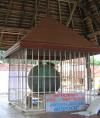Kunchan Nambiar poet from India was born in 1705, had 65 years and died in 1770. Poems were written mainly in Hindi language. Dominant movement is prevalent form.
Biography
Kunchan Nambiar was an early Malayalam language poet, performer, satirist and the inventor of local art form Ottamtullal. He is often considered as the master of Malayalam satirist poetry.
Kunchan Nambiar spent his early childhood at Killikkurussimangalam, his boyhood at Kudamalur and youth at Ambalappuzha. In 1748 he moved to the court of King Marttanda Varma of Travancore Kingdom and later to the court of his successor Dharma Raja. He had already written several of his works before leaving Aluva. Scholars like Mani Madhava Cakyar have the opinion that he and the Sanskrit poet Rama Panivada are the same. ("Panivada" means "Nambiar" in Sanskrit).
Nambiar's poetry lacks the high seriousness such as we find in Ezhuthachan. The difference here is significant. The two are complementary. Just as Kilipattu seems to express the total personality of a writer like Ezhuthachan, the Thullal brings out the characteristic features of the personality of Nambiar. Between them they cover the entire spectrum of humanity, the entire gamut of human emotions. No other Kilipattu has come anywhere near Ezhuthachan's Ramayanam and Mahabharatam, no other Thullal composition is ever likely to equal the best of Nambiar's compositions.
Literary Career
The chief contribution of Kunchan Nambiar is the popularization of a performing art known as Tullal. The word literally means "dance", but under this name Nambiar devised a new style of verse narration with a little background music and dance-like swinging movement to wean the people away from the Cakyar Kuttu, which was the art form popular till then.
He used pure Malayalam as opposed to the stylized and Sanskritized Malayalam language of Cakyar Kuttu. He also adopted many elements from Padayani and Kolam Tullal and certain other local folk arts. It is reasonable to assume that he was himself a Tullal performer and writer. The first hand knowledge of the various talas and ragas (and even the practices of drummers) is a pre-requisite for the writing of a Tullal. Each Tullal composition consists of a local Puranic tale retold in simple rhythmic verse, fit for loud recitation before an local audience.
There are three kinds of Tullal distinguished on the basis of the performer's costume and the style of rendering, viz., Ottan, Sitankan and Parayan. Dravidian metres are used throughout although there is a quatrain in a Sanskrit metre. Kunchan Nambiar also developed new metres (for example; Vaytari metres) based on the vocal notation for various talas. The language is predominantly Malayalam with a large admixture of colloquial and dialectal forms. Kunchan Nambiar is often considered as the master of Malayalam satirist poetry. Humour is invariably the dominant mood in his works: other bhavas are brought in for variety and to suit the situation.
One of the oft-quoted lines from his poems are; "Nokkeda nammude margey kidakkunna markada niyangu mari kida saddha!" (in Nambiar's retelling of the ancient Indian epic Mahabharatha, Prince Bhima of the Pandavas tells half-brother monkey god Hanuman to move from his way, by saying "Go lie elsewhere, you obstinate monkey!"). ..






